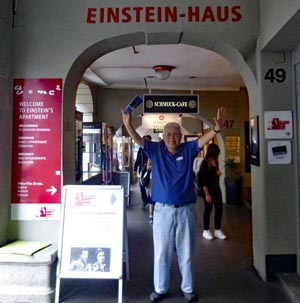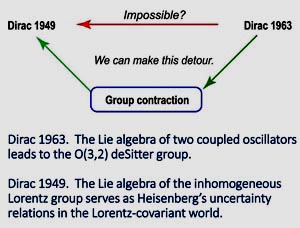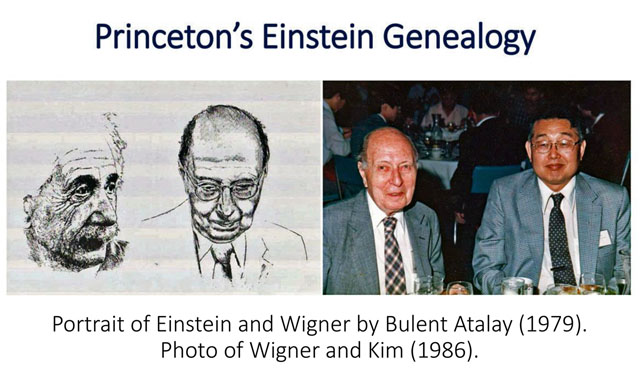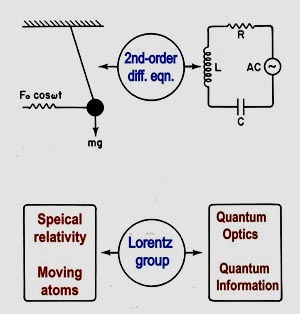
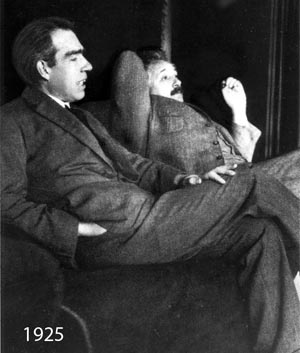
|
Bohr and Einstein, photo from the AIP Visual Archives.
|
- One hundred years ago,
Bohr and Einstein met occasionally to discuss physics.
Bohr was worrying about why the energy levels of the hydrogen atom
are discrete, while Einstein was interested in how things look to moving
observers. Did they ever discuss how the hydrogen atom looks to a moving
observer?
- Bohr's worry became the present form of quantum mechanics where the
hydrogen atom is a quantum bound state or a standing wave. Thus, the
problem becomes that of a
moving bound state
in Einstein's world.
In Einstein's world, moving objects appear differently according to
Lorentz transformations. Click here
for illustrations.
- While there are no observable hydrogen hydrogen atoms moving with relativistic
speeds (speed comparable with the light speed), modern accelators started producing
protons with relativistic speed, after 1950. The question is then what does the
proton has to do with bound states like the hydrogen atom.
- According to Gell-Mann (1954), the proton at rest is a bound state of three quarks .
According to Feynman (1969), the proton moving with the velocity close to that of
light appears as a collection of an infinite number partons. Are they talking
about the same proton? This question is illustrated in this figure:
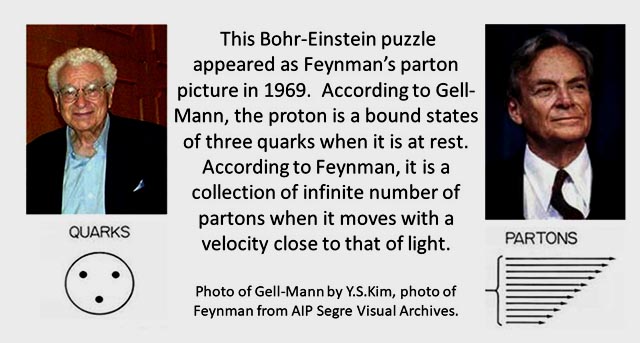
- Click here for the resolution of
the quark-parton puzzle. For the moving bound state, it is possible to
construct the harmonic oscillator wave functions that can be Lorentz-boosted.
We can call them Covariant Harmonic Oscillators and construct the following
table.
Einstein's World
|
Massive/Slow |
between |
Massless/Fast |
|
Energy
Momentum |
E=p2/2m |
Einstein's
E=(m2 + p2)1/2 |
E=p |
|
|
|
- The question then is how to construct the Lorentz-covariant harmonic
oscillator wave functions. Paul A. M. Dirac made his life-long efforts
to construct Lorentz-covariant ocillator wave functions. We can mention
the following four papers.
- P. A. M. Dirac,
The Quantum Theory of the Emission and Absorption of Radiation,
Proc. Roy. Soc. (London) A [114], 243 - 265 (1927).
- P. A. M. Dirac,
The Quantum Theory of the Emission and Absorption of Radiation,
Proc. Roy. Soc. (London) A [A183], 284 - 295 (1945).
- P. A. M. Dirac,
Forms of Relativistic Dynamics,
Rev. Mod. Phys. [21] 392 - 399 (1949).
- P. A. M. Dirac,
A Remarkable Representation of the 3 + 2 de Sitter Group,
J. Math. Phys. [4], 901 - 909 (1963).
I had the privilege of meeting Dirac in 1962 and learn his physics directly from
him. His papers are like poems and enjoyable to read. However, his papers
do not contain figures or illustractions. Another problem is that Dirac never
quotes hiw own papers published earlier on the same subject. Presumably, he thought
he was presenting new ideas when he wrote those papers.
We can thus translate his pictures into cartoons and combine those cartoons.
The net result is

This ellipse (squeezed circle) can provide the resolution of the quark-parton puzzle
and thus the Bohr-Einstein issue. Click here
for a detailed story.
For a published papers on this subject, go to
-
Integration of Dirac’s Efforts to Construct a Lorentz-covariant Quantum
Mechanics,
with Marilyn E. Noz.
Symmetry [12(8)], 1270 (2020),
doi:10.3390/sym12081270,
-
Physics of the Lorentz Group, Second Edition: Beyond High-energy Physics
and Optics,
with Sibel Baskal and Marilyn Noz,
to be published by the IOP (British Institute of Physics).
- As for
Dirac's 1963 paper on the two-oscillator sysem, he constructed a Lie
algebra (closed set of commutation relations for the generators of the group)
for the Lorentz group applicable to three space-like dimensions and two
time-like dimensions. This group is known as the O(3,2) deSitter group.
The remarkable fact is that this set was constructed solely from Heisenberg's
brackets for his uncertainty relations. How is it possible to derive a set
of equations for Einstein's relativity from those for quantum mechanics?
The remaining question is to transform the second time variale of the O(3,2)
system into a useful variable in the Minkowskian system of three space
coordinates and one time. Indeed, it is possible through the group contration
techique. I published a number of papers on this issue.
- Poincaré Symmetry from Heisenberg's Uncertainty Relations,
with S. Baskal and M. E. Noz,
Symmetry [11(3)], 236 - 267 (2019),
doi:10.3390/sym11030409,
-
Einstein's E = mc2 derivable from Heisenberg's Uncertainty Relations,
with Sibel Baskal and Marilyn Noz,
Quantum Reports [1(2)], 236 - 251 (2019),
doi:10.3390/quantum1020021,
-
Physics of the Lorentz Group, Second Edition: Beyond High-energy Physics
and Optics,
with Sibel Baskal and Marilyn Noz,
to be published by the IOP (British Institute of Physics).
- What do they say about me?
- Video
from the Marquis Who's Who.
- Video
from the IAOTP (International Association of Top Professionals).
|
|
|

